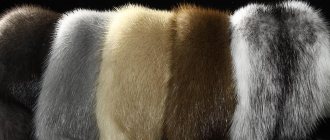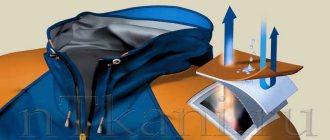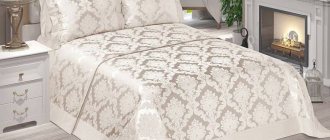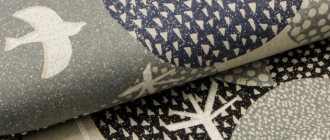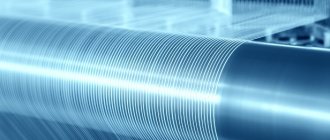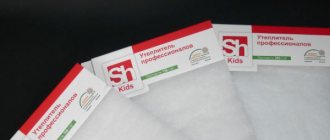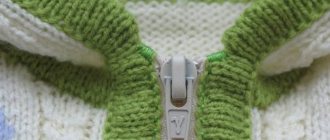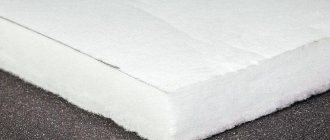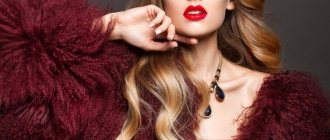In the modern clothing industry, synthetic fleece knitwear plays a significant role. This invention of American manufacturers is just over 35 years old, but it has already gained popularity and spread throughout the world; a large number of different products for the home have begun to be made from it. In this article we will take a closer look at fleece fabric in clothing and take a closer look at what it is: the composition of the material, properties, characteristics, and we will provide photos of its different types. Features of threads, their production. The word Fleece translated from English means sheep's wool, sheared from one sheep. The product is truly comparable in quality to natural fleece; it is, one might say, an artificial analogue of sheepskin. In terms of its parameters, it turned out to be a worthy alternative to a natural element, only less absorbent of water and more breathable. The authorship belongs to the company Malden Mills, which began experimenting with polyester to make a plastic substitute for the warmest natural structure. A team of engineers managed to create a dense fabric from tiny polyester threads. Outwardly, it resembled terry cloth, only it turned out to be lighter. After combing it, the volume of the pile increased significantly, and it was found that the fabric did not absorb moisture.
Subsequently, the invention went through many stages of improvement. The result is a product that has the best characteristics of wool, but is devoid of its disadvantages. In comparison with its synthetic analogue:
- does not absorb moisture;
- does not have any repulsive odors;
- does not deform when dried;
- is light;
- does not cause allergic reactions.
In 2007, Malden Mills reorganized and was succeeded by Polartec, LLC.
At the moment, more than 300 types of products are produced under the name of this brand. Polar Fleece is supplied to Russia mainly from China and the USA. High quality distinguishes the products of Eddie bauer, North face, Patagonia, Lands end, Llbean corporations, which is confirmed by their many years of practice.
Domestic production is also largely represented by structures that came to the Russian market from abroad. In particular, a company specializing in ski equipment, Stayer. The company offers a wide range of products intended for winter sports.
Manufacturing features, properties
Let's look at what fleece fabric is and what it is made from.
At the first stage, the finest threads are obtained from polyethylene terephthalate (PET) fibers, and then they are tied into a dense polyester base. Next, the resulting web is driven through the brush plane. On equipment with brushes, loops are pulled out of it, creating a kind of pile on the surface. The result is a fluffy pile from these polymer nodules, in which many air pores are formed. The material noticeably increases in size without adding weight. A similar cushion of air and polymers gives it softness and heat protection.
The resulting product undergoes a special cleaning treatment, which ensures its ideal shape throughout the entire period of wear. The product is processed with various mixtures that reduce its flammability (when a fire is applied it begins to melt), impart water-repellent or other certain qualities.
Description, composition, types of fiber
To the question: “Is fleece synthetic or natural fabric?”, there can be only one answer - Fleece is a 100% artificial fabric, polyester knitwear.
It has a fluffy surface on both sides, pleasant and soft to the touch. Models are distinguished by density, processing method, structure and appearance.
The first indicator can be from 100 to 600 grams per square meter. The clogging of each loop with lint, softness and thermal insulation qualities depend on this. The cost of the product and its durability also directly depend on the filling method. Types of fleece:
- Models with the smallest thickness are called microfleece, which allows it to be used with this value only for sewing thin products: underwear, pajamas, etc.
- A little thicker - polar fleece, its features make it possible to sew jackets, light sweatshirts, and thermal underwear from it.
- The most popular is medium-density fabric (from 200 g/m2). It is used to make children's clothes, hats, scarves, and mittens.
- More solid items are created from knitwear of higher than medium density: winter clothes, home textiles.
- The thickest fabric is used for sewing tourist and mountaineering gear and equipment. This is the high-quality material that Stayer uses.
Currently, products are subjected to a whole range of processing procedures.
They can be produced on one or both sides. Manufacturers add additional elements to the composition, which gives it modern quality characteristics and new names:
- add Lycra - to enhance wear resistance, spandex - for elasticity (suitable for making gloves);
- they make a two-layer product: the top layer protects from wind and rain, the inner layer insulates;
- They produce a version with improved protective parameters, with an intermediate membrane layer between 2 rows of Polar Fleece - windblock.
Consumers often have a question: is fleece warm or not? As we have already noted, there are miniature air bubbles inside the pile, which successfully serve as a reliable heat insulator. The thicker the polymer structure, the more oxygen in the pores and the warmer the clothing will be. Airiness gives lightness to the material, allows it to be compressed and easily packed.
Advantages and disadvantages
The combination of fleece properties is truly unique. Its advantages include:
- low specific gravity of products;
- breathability - the air freely penetrates through the fabric, the skin breathes, it is difficult to sweat in a fleece garment;
- waterproof - the product does not absorb water and dries quickly;
- sufficient heat protection and thermoregulation: a jacket or cardigan made from it is capable of maintaining a favorable temperature, which prevents it from freezing or sweating;
- washing machine permissibility;
- preservation of heat-protective characteristics in a wet state;
- sufficient wear resistance and abrasion resistance;
- easy to care for: fleece items are easy to wash, no need to iron;
- no allergic reactions to knitwear;
- elasticity: clothes do not interfere with movement, and at the same time do not change the original shape.
Fleece can be exposed to the sun, moisture, and frost for a long time without losing its original qualities.
The appearance of the products is perfectly preserved even after many washes. The disadvantages include:
- the ability to accumulate static electricity and be subject to electrification;
- the ability to collect dust;
- highly flammable unless appropriate treatment is carried out.
Fabric production and characteristics
Camouflage fabrics are often used in extreme conditions, so they must meet certain requirements. Among them:
- the shape must be durable, last a long time, and not be subject to severe deformation;
- wear out as little as possible, do not fade in the sun;
- the material must “breathe”, allow air to pass through, and be ventilated;
- be resistant to moisture, protect from wind.
Important! For individual troop units, additional material characteristics are needed. For example, resistance to chemical reagents, fire, infrared remission (cannot be detected by a night vision device). The latter property is achieved by applying special reflective dyes.
Options for camouflage fabric with protection from night vision devices
Application for the production of workwear
Thick types are produced for sewing insulated workwear. It is applicable to people working outdoors in cold air. The material is used to make work trousers, clothing for those who like fishing and hunting, and camouflage uniforms. It is hemmed as lining into work overalls, mittens, and hats.
Use in other areas
The product in question makes good jackets and sweaters, usually for sports or tourism purposes.
They are worn over thermal underwear, and on top is a piece of breathable fabric with a membrane. Fleece products are great for active sports. There is always an air gap in the pile, and it is an excellent thermal insulator. Equipment for athletes from various versions of Polar creates the necessary internal ventilation when overheating and removes condensation outside. An example of this is a warm jacket in which you can ski, even high in the mountains. You can find out what a “fleece” is and buy this product in the Stayer online store. You can view the range of similar products on the company’s official website.
But one condition must be observed. For the properties of the material to work, the above clothing must be worn over thermal underwear. If you use a cotton T-shirt, it will quickly become wet, and the full effect of using the polymer will be lost.
Fleece, by its characteristics, is literally created for children's clothing. It not only provides the child with comfort and warmth, but also lasts a long time, always looks good, and is suitable for all babies from birth. In winter, a base layer is often added for the jacket.
What is a fleece lining? This is a soft insulation for hats, jackets, and mittens.
Products in the manufacture of which this fabric is used:
- Pajamas and home suits are made from the finest material.
- Linings, warm sweaters and overalls are made from slightly denser fabric.
- Jackets for children and teenagers are made from a particularly durable type.
- It has become widespread when products for children are lined with fleece, which is convenient, and most importantly, it is practical for children, both for hiking and for everyday wear in winter.
The material is able to retain rich, bright colors, which consumers like.
Application area
Warm clothes (sweatshirts, trousers, hats) are made from polar fleece. Polar fleece is used as a filling or lining when sewing jackets and other outerwear.
Tourist equipment, suits for fishermen and hunters, and workwear are made from double-sided material. For example, the demi-season “Taiga” polar fleece suit. It consists of trousers and a jacket, designed for a temperature range from +2°C to +15°C.
They make clothes for children from polar fleece. These include sweatshirts, trousers, overalls, envelopes and vests. The fabric is also used for sewing children's outerwear, hats, and scarves.
I found a use for polar fleece when sewing thermal underwear. For these purposes, use windblock or microfleece.
Home textiles are made from polar fleece: blankets and bedspreads. They are warm, pleasant to the touch, and retain their attractive appearance for a long time.
Nuances of care
One of the advantages of Fleece is its ease of use.
It washes well, dries instantly, and does not require subsequent ironing.
However, its synthetic composition requires compliance with some simple conditions:
- Polyester fabrics can be washed at a water temperature of no higher than 40 degrees; if you use a machine method, then on a gentle cycle, without intense exposure. It is strictly not recommended to twist or spin at high speeds; the item may lose its shape.
- It is better to hang the product on hangers so that the moisture runs off, and then dry it on a towel. Do not dry on hot radiators, heaters, or over an open fire.
- Ironing is also not allowed, since at 60 degrees the polymer begins to break down and melt.
- There is no need to use washing powders. It is safer to use the liquid form. After using detergents, it is recommended to rinse thoroughly.
In short, the unique qualities of fleece, as a modern and practical material, are increasingly used in the manufacture of sports, tourism, children's and casual clothing.
It is becoming in demand among consumers of different ages and needs. The product is being improved, new modifications and additions to the main fabric appear. When choosing products, it is important to pay attention to the manufacturer; it is better to contact those who have already established themselves in the market. Among the manufacturers of products for alpine skiing, snowboarding and long walks in the cold season, Stayer has established itself as a company that produces stylish items at a low price. In the article, we talked about the features of the material, explained what polar fleece and microfleece are, as well as how to use this fabric.
Types of fabrics and color choices
Despite the similarity in external parameters, all camouflage suits are made from different materials. For summer models, the following types of fabrics are most often used:
- Natural cotton – have good breathable properties;
- Raincoat - has a synthetic composition and provides good protection from moisture. Has good wear resistance and is easy to wash;
- Polyester and nylon fibers protect against getting wet and blown by the wind. They have high strength and practicality;
- Rip stop is a modern durable fabric that is endowed with special reinforced threads. A suit made of this material is reliably protected from various damages.
- Peach Soft Ultra fabric is a velvety fabric of increased wear resistance with a water-repellent coating and contains 100% cotton.
The choice of a summer camouflage suit is influenced not only by the composition of the fabric from which it is made, but also by its color. If clothing is selected for outdoor activities, then its color is not so important, but if it is required for hunting or all kinds of military operations, this is one of the most important selection criteria. From the wide variety, several options can be distinguished:
- Multicam is a drawing consisting of three colors, the priority of which is green;
- Moss - the color imitates a forest thicket;
- Khaki is a range of shades from dirty yellow to green-brown. They are suitable for flat and mountainous terrain without dense vegetation;
- Digital – suitable for almost any type of terrain.
These are the main colors, but there are many others. Various manufacturers of camouflage suits give their own definition. They are developed taking into account Russian natural and climatic conditions.
